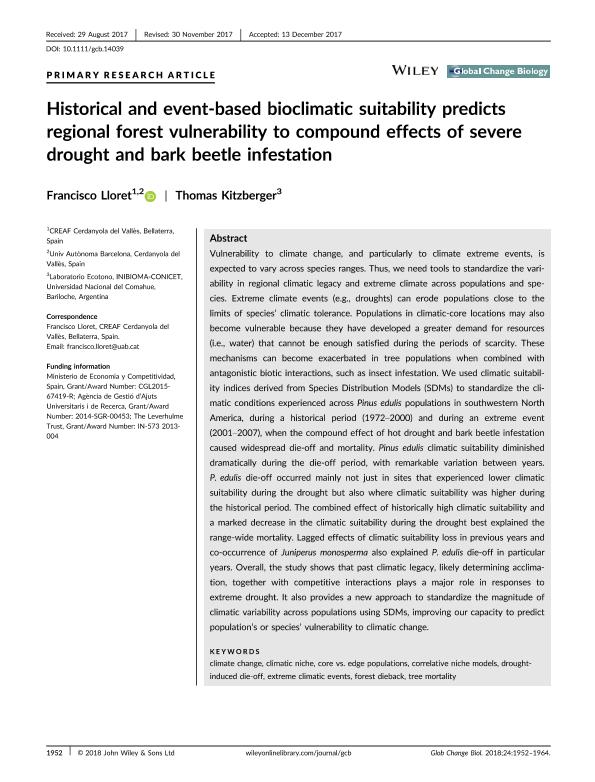Artículo
Historical and event-based bioclimatic suitability predicts regional forest vulnerability to compound effects of severe drought and bark beetle infestation
Fecha de publicación:
05/2018
Editorial:
Wiley Blackwell Publishing, Inc
Revista:
Global Change Biology
ISSN:
1354-1013
Idioma:
Inglés
Tipo de recurso:
Artículo publicado
Clasificación temática:
Resumen
Vulnerability to climate change, and particularly to climate extreme events, is expected to vary across species ranges. Thus, we need tools to standardize the variability in regional climatic legacy and extreme climate across populations and species. Extreme climate events (e.g., droughts) can erode populations close to the limits of species' climatic tolerance. Populations in climatic-core locations may also become vulnerable because they have developed a greater demand for resources (i.e., water) that cannot be enough satisfied during the periods of scarcity. These mechanisms can become exacerbated in tree populations when combined with antagonistic biotic interactions, such as insect infestation. We used climatic suitability indices derived from Species Distribution Models (SDMs) to standardize the climatic conditions experienced across Pinus edulis populations in southwestern North America, during a historical period (1972–2000) and during an extreme event (2001–2007), when the compound effect of hot drought and bark beetle infestation caused widespread die-off and mortality. Pinus edulis climatic suitability diminished dramatically during the die-off period, with remarkable variation between years. P. edulis die-off occurred mainly not just in sites that experienced lower climatic suitability during the drought but also where climatic suitability was higher during the historical period. The combined effect of historically high climatic suitability and a marked decrease in the climatic suitability during the drought best explained the range-wide mortality. Lagged effects of climatic suitability loss in previous years and co-occurrence of Juniperus monosperma also explained P. edulis die-off in particular years. Overall, the study shows that past climatic legacy, likely determining acclimation, together with competitive interactions plays a major role in responses to extreme drought. It also provides a new approach to standardize the magnitude of climatic variability across populations using SDMs, improving our capacity to predict population's or species' vulnerability to climatic change.
Archivos asociados
Licencia
Identificadores
Colecciones
Articulos(INIBIOMA)
Articulos de INST. DE INVEST.EN BIODIVERSIDAD Y MEDIOAMBIENTE
Articulos de INST. DE INVEST.EN BIODIVERSIDAD Y MEDIOAMBIENTE
Citación
Lloret Sarmiento, Francisco Jose; Kitzberger, Thomas; Historical and event-based bioclimatic suitability predicts regional forest vulnerability to compound effects of severe drought and bark beetle infestation; Wiley Blackwell Publishing, Inc; Global Change Biology; 24; 5; 5-2018; 1952-1964
Compartir
Altmétricas




